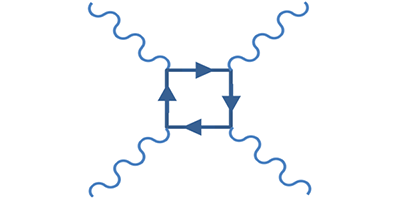Spotlight on Photon-Photon Scattering
Despite what movie lightsabers suggest, light beams pass through each other without effect. However, two photons will, on rare occasion, bounce off each other. This elastic photon-photon scattering, which occurs via intermediate particles, has never been observed directly, but a new analysis in Physical Review Letters shows that the Large Hadron Collider (LHC) at CERN could detect around 20 photon-photon events per year.
Photons only interact with charged particles, so they shouldn’t interact with themselves. But quantum physics allows for a photon to temporarily fluctuate into a particle-antiparticle pair (such as an electron-positron pair), and one of these charged particles can absorb a second photon. When these intermediate particles recombine, they emit two photons. The whole process appears as two photons ricocheting off each other, but it has only been observed indirectly by its effect on the magnetic moments of the electron and muon.
In their direct detection strategy, David d’Enterria of CERN, Switzerland, and Gustavo Silveira of the Catholic University of Louvain in Belgium propose using the large flux of “quasireal” photons in the LHC. These are not physical photons but instead are the carriers of the strong electromagnetic forces that surround the protons or lead ions zooming around in the collider. If two quasireal photons scatter off each other, they assume a real nature and can be detected in the LHC detectors. Using computer simulations, the authors show that lead-lead collisions provide the best opportunity for seeing these photon-photon scattering events. Any deviation from the predicted counts could be evidence of new physics, such as the existence of supersymmetry. – Michael Schirber





